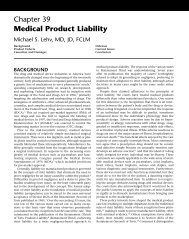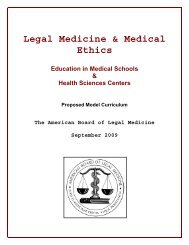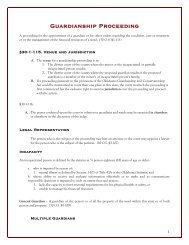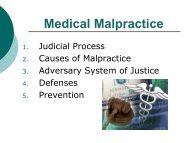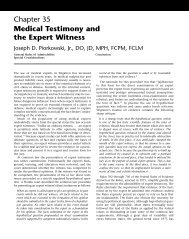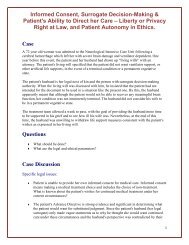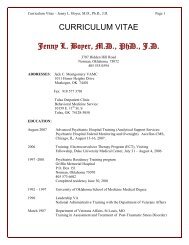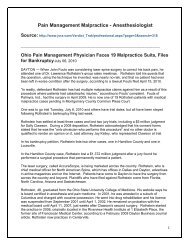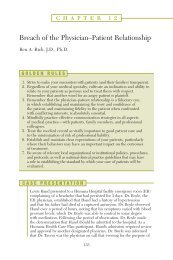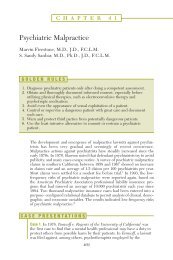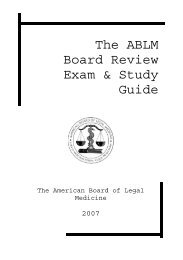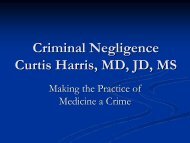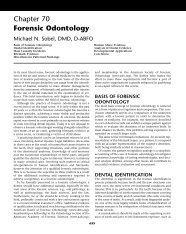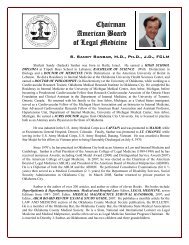Chapter 65 Forensic Engineering - Legal Medicine and Medical ...
Chapter 65 Forensic Engineering - Legal Medicine and Medical ...
Chapter 65 Forensic Engineering - Legal Medicine and Medical ...
You also want an ePaper? Increase the reach of your titles
YUMPU automatically turns print PDFs into web optimized ePapers that Google loves.
Ch<strong>65</strong>-A03753 12/14/06 12:04 PM Page 614<br />
614 <strong>Forensic</strong> <strong>Engineering</strong><br />
or malfunction of any component is traced throughout the<br />
entire system. Flow sheets <strong>and</strong> computer programs are available<br />
to assist the engineering design team in this procedure,<br />
which screens the entire system. If the component failure<br />
results in a hazard that can cause injury, it is identified <strong>and</strong><br />
necessary design changes should be made to remove the<br />
hazard <strong>and</strong>/or protect the user.<br />
■ Fault-tree analysis (FTA).<br />
The FTA is a top-to-bottom procedure where the undesirable<br />
outcome (top event or fault condition) is the starting<br />
point. This top event is then traced down through the system<br />
<strong>and</strong> the failures of individual components or events that<br />
can lead to the undesirable outcome are identified. Design<br />
changes are then made as required to eliminate or minimize<br />
the probability of the occurrence of the fault condition.<br />
The FTA is a complicated procedure, which is used to analyze<br />
complex systems, e.g., a space shuttle; it relies heavily on<br />
Boolean algebra techniques <strong>and</strong> symbols <strong>and</strong> is most often<br />
done on a digital computer.<br />
■ Product safety audit (PSA).<br />
The PSA is basically a checklist containing hundreds,<br />
if not thous<strong>and</strong>s, of questions concerning the design of the<br />
product. The questions are framed in a manner such that a<br />
negative answer triggers further investigation, which may<br />
lead to a design change. The major drawback, as with any<br />
checklist procedure, is that if the list of questions is incomplete,<br />
a defect can be easily overlooked.<br />
Once the hazards in a product or system are identified<br />
by a proper hazard identification analysis, the engineer follows<br />
a codified procedure known as the “safety hierarchy”<br />
in order to prevent or minimize the probability of personal<br />
injury. This hierarchy is not a law of nature or a scientific<br />
law but rather a logical procedure that has been adopted by<br />
consensus <strong>and</strong> has the priorities shown in Table <strong>65</strong>-2, in<br />
the order in which they should be used.<br />
Typically, in products liability investigations applicable<br />
to consumer products, only the first three priorities are<br />
normally considered part of the safety hierarchy.<br />
Furthermore, the line between the first <strong>and</strong> second priorities<br />
can sometimes become blurred, depending on the product<br />
<strong>and</strong> its environment of use. This is because providing a<br />
proper guard can be thought of as an integral part of the<br />
overall design process, which includes considerations of<br />
man–machine interface safety in the concept stage <strong>and</strong> all<br />
design stages of product development. However, if the<br />
product is, say, a h<strong>and</strong>-held circular saw, the rotating blade<br />
First priority<br />
Second priority<br />
Third priority<br />
Fourth priority<br />
Fifth priority<br />
Table <strong>65</strong>-2 Safety hierarchy<br />
Design out the hazard if it is practical <strong>and</strong> fea<br />
sible to do so.<br />
If the hazard cannot be designed out, guard<br />
against the hazard.<br />
Provide proper warnings concerning the haz<br />
ards <strong>and</strong> instructions for use of the product.<br />
If applicable, provide training in the safe use<br />
of the product or system.<br />
If applicable, prescribe personal protective<br />
equipment.<br />
is essential to the cutting function <strong>and</strong> obviously cannot<br />
be eliminated. Hence, the second priority would call for a<br />
blade guard to protect against inadvertent contact with the<br />
blade. Whenever a design change is contemplated, it is<br />
essential that the engineer examine the alternative design(s)<br />
for new hazards which may be introduced by the change(s).<br />
The alternative design(s) may not be as safe as the original<br />
design <strong>and</strong> the engineer must decide on which features to<br />
include in the final design.<br />
Regarding warnings, it is important to emphasize that<br />
properly designed warnings, which can be words <strong>and</strong>/or<br />
pictographs, have to communicate three things to the user,<br />
i.e., what the hazard is, the steps the user can take to avoid<br />
the hazard, <strong>and</strong> what the likely consequences can be if the<br />
warnings are disregarded. Pictographs may be preferable to<br />
words since they can be more dramatic, in addition to<br />
eliminating a possible language barrier in locales where more<br />
than one language is commonly spoken. It should also be<br />
emphasized that too many warnings on a product may<br />
destroy their effectiveness. Furthermore, <strong>and</strong> very important,<br />
warnings should never be used by a manufacturer to disclaim<br />
liability <strong>and</strong> are never ever a substitute for a safe design<br />
that is practical <strong>and</strong> feasible to achieve.<br />
CONCLUSION<br />
The purpose of this short chapter has been to expose the<br />
reader to the exciting <strong>and</strong> rapidly developing field of forensic<br />
engineering. In addition, forensic scientists are encouraged<br />
to utilize the services of forensic engineers in injury <strong>and</strong><br />
death investigation cases. The topics discussed in the chapter<br />
are necessarily limited in scope <strong>and</strong> the interested reader is<br />
referred to the bibliography for references to further applications<br />
<strong>and</strong> in-depth treatments. The bibliography is provided<br />
for representative coverage of the field without endorsement<br />
of any publication. An attempt has been made to generally<br />
group the bibliography by subject matter, as discussed in<br />
the chapter, although there is considerable overlap.<br />
Bibliography<br />
<strong>Forensic</strong> <strong>Engineering</strong><br />
S.C. Batterman & S.D. Batterman, <strong>Forensic</strong> <strong>Engineering</strong>, in McGraw-<br />
Hill Yearbook of Science <strong>and</strong> Technology (2002).<br />
S.C. Batterman & S.D. Batterman, <strong>Forensic</strong> <strong>Engineering</strong>, in Medicolegal<br />
Death Investigation Manual: Treatises in the <strong>Forensic</strong> Sciences,<br />
2d ed., chap. 12 (<strong>Forensic</strong> Science Foundation Press, 1999).<br />
K.L. Carper (ed.), <strong>Forensic</strong> <strong>Engineering</strong>, 2d ed. (CRC Press, 2001).<br />
H. Petroski, To Engineer Is Human: The Role of Failure in Successful<br />
Design (St. Martin’s Press, 1985).<br />
N. Putchat, <strong>Forensic</strong> <strong>Engineering</strong>—a Definition, 29 J. <strong>Forensic</strong> Sci.<br />
375–78 (1984).<br />
Newton’s Laws <strong>and</strong> Principles<br />
of Classical Dynamics<br />
F.P. Beer & E.R. Johnston, Vector Mechanics for Engineers: Statics <strong>and</strong><br />
Dynamics (McGraw-Hill, 1977).<br />
D.T. Greenwood, Classical Dynamics (McGraw-Hill, 1977).<br />
H. Yeh & J.I. Abrams, Principles of Mechanics of Solids <strong>and</strong> Fluids:<br />
Particle <strong>and</strong> Rigid Body Mechanics (McGraw-Hill, 1960).



